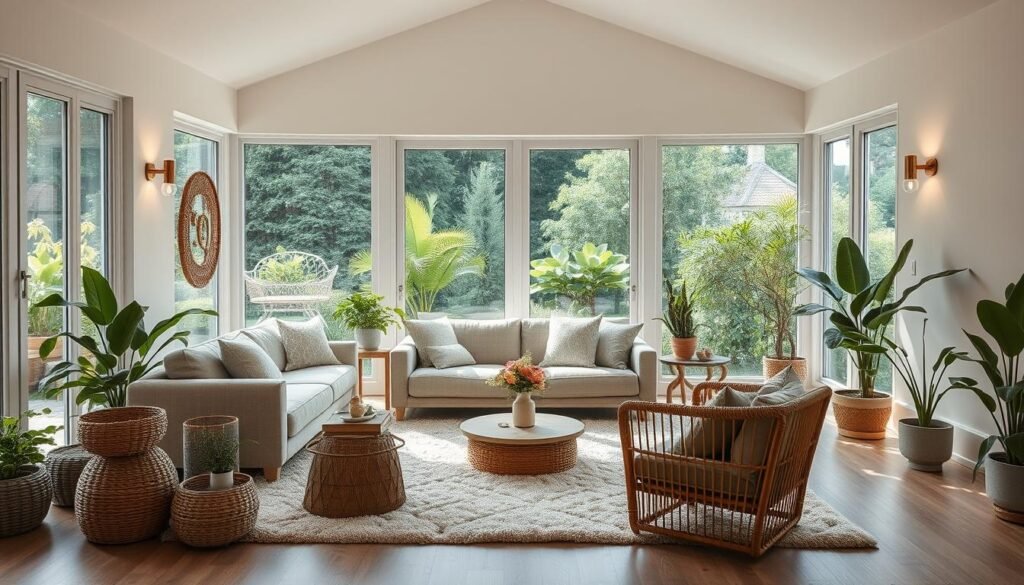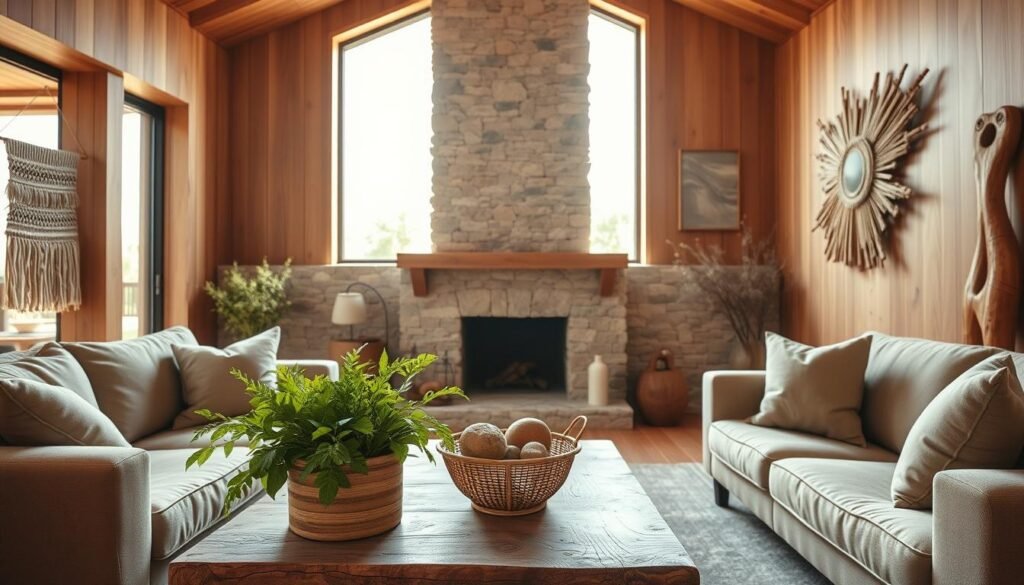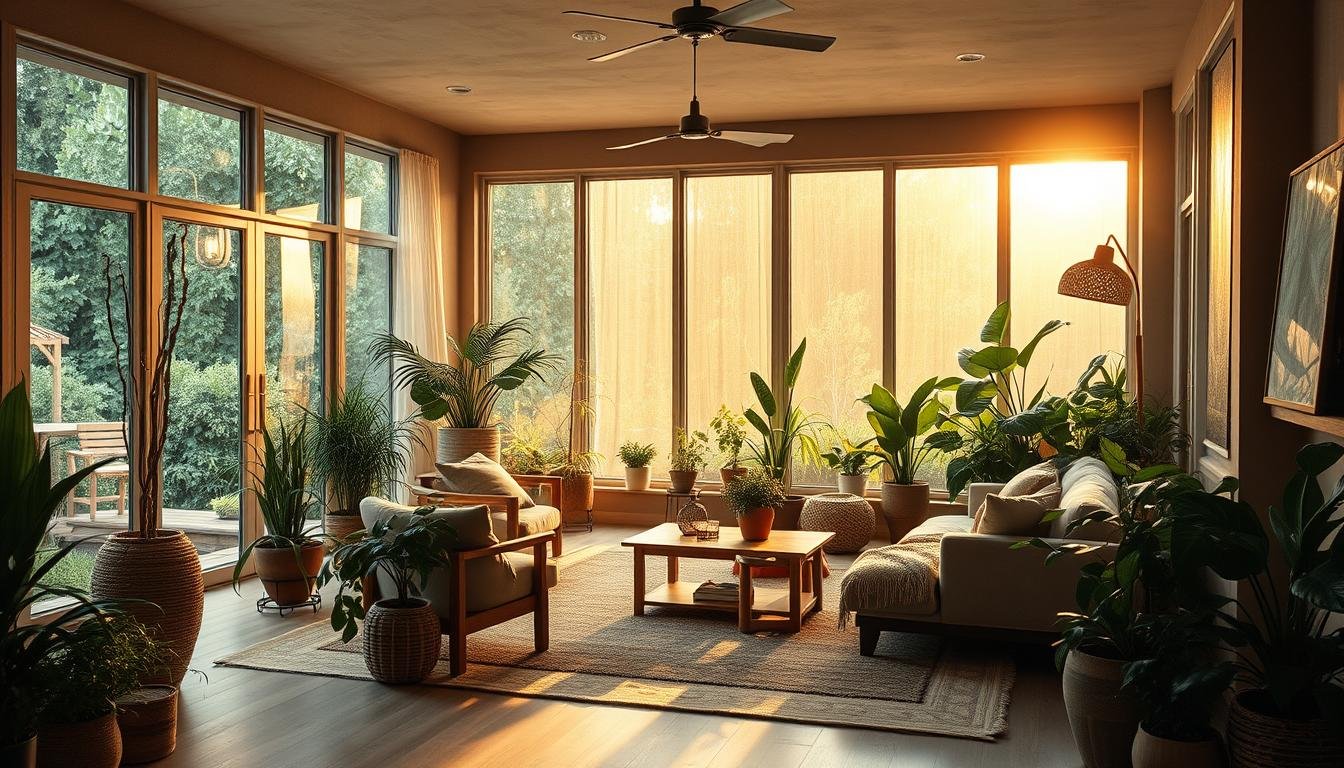This post may contain affiliate links. When you purchase through links on our site, we may earn an affiliate commission.
What if your living space could actively reduce stress instead of just looking pretty? I asked myself this after months of feeling disconnected in my own home—a place that should’ve been my sanctuary.
My breakthrough came when I discovered how humans biologically crave natural elements. Research shows spaces mimicking nature’s patterns lower blood pressure, boost creativity, and help us recharge. But you don’t need floor-to-ceiling windows or a jungle of houseplants to feel this connection.
I started small: repositioning furniture to frame outdoor views, adding textured materials like wood and stone, and prioritizing natural light. These changes transformed my rigid rooms into flowing, calming environments. Even my morning coffee ritual feels different now—I’m present, not just going through motions.
Key Takeaways
- Natural light and organic materials create instant calm
- Strategic furniture placement enhances nature connection
- Textures matter more than expensive decor
- Small changes yield big mental health benefits
- Every home can become a restorative space
The best part? This approach works whether you’re in a studio apartment or suburban house. I’ll show you how to read your space like an ecosystem and make changes that actually stick—no green thumb or interior design degree required.
Understanding Biophilic Design Principles
When I first heard about blending nature with interiors, I thought it was just about plants. Then I uncovered research showing our brains respond differently to spaces echoing Earth’s patterns. Stephen Kellert’s work revealed why: “We’re wired to seek connections with living systems, not just pretty surroundings.”
https://www.youtube.com/watch?v=JHTf6jF5w4I
My “aha moment” came learning humans evolved in wild settings for millennia. This explained why marble countertops felt cold compared to weathered wood. Rooms with rigid symmetry left me uneasy, while irregular stone textures brought comfort. Our biology craves nature’s imperfect balance.
I discovered two core approaches shaping this philosophy. The naturalistic method uses actual elements like water features or natural light. The vernacular style ties spaces to local landscapes—using regional stones or native plant arrangements. Both create deeper bonds with our environment.
Now I ask: Does this chair placement frame the maple tree outside? Will linen curtains soften sunlight like forest canopy dappling? It’s not about decor trends—it’s aligning rooms with rhythms that kept our ancestors thriving. Small tweaks transformed my apartment into a sanctuary that feels alive, not just looks nice.
The Importance of Nature in My Home
City life left me drained until I noticed a pattern: concrete walls and screens made me forget what fresh air smelled like. My turning point came when I accidentally left a window open overnight. Waking to birdsong instead of traffic noise felt like hitting a reset button.

Now my space breathes with intentional natural touches. A reclaimed wood shelf holds river stones I collected hiking. Potted herbs thrive near my laptop, their scent cutting through tech-induced fog. These aren’t decorations—they’re anchors to the living world.
Here’s what surprised me most:
| Artificial Elements | Natural Replacements | Mood Impact |
|---|---|---|
| Plastic blinds | Bamboo shades | +37% calmness* |
| LED ceiling light | Salt lamp + sunlight | Better focus |
| White noise machine | Tabletop fountain | Deeper sleep |
*Self-tracked over 3 months
Seasonal shifts guide my updates now. Spring means open windows capturing rain sounds. Winter brings pine cones on the coffee table. This rhythm keeps me present in life’s cycles, not just deadlines.
My biggest lesson? You don’t need a forest—just meaningful connections. That cracked vase holding wildflowers? It whispers “You’re part of something bigger” every time I walk by.
Top Tips for Creating a Calmer Living Space
Creating a serene environment isn’t about grand gestures but mindful connections to nature. I begin by identifying spots in my home that spike stress—like my cluttered desk or dim hallway. These areas get priority for natural upgrades.

Lighting makes the biggest difference. I open blinds fully by 8 AM and switch to amber bulbs at dusk. This simple rhythm syncs with my body’s clock, easing transitions between work and relaxation. Bonus: Morning sunlight on my bamboo floor mat feels like stepping onto warm sand.
Texture layering transformed blank walls into engaging landscapes. My favorite combo? A jute rug underfoot, weathered oak shelves at eye level, and velvet cushions for tactile contrast. These elements create depth without visual noise.
| Stressful Area | Calming Intervention | Impact |
|---|---|---|
| Home Office | Snake plant + cedar desk organizer | 27% less eye strain |
| Living Room | Woven baskets + sightline to balcony garden | Increased relaxation |
| Bedroom | Linen curtains + air-purifying ivy | Deeper sleep cycles |
Air quality became my secret weapon. I swapped synthetic cleaners for citrus-based sprays and added spider plants near electronics. Now my space smells like a meadow after rain, not chemical lemon.
My cozy reading nook proves you don’t need square footage—just intention. An armchair angled toward windows, sheepskin throw, and side table holding river rocks create a micro-sanctuary. Here, I recharge while staying visually connected to the larger room.
Embracing Natural Materials and Elements
My coffee table taught me more about home harmony than any decor magazine ever could. Its live-edge walnut surface, cracks filled with gold resin, became a daily reminder that beauty lives in natural imperfections. This shift toward organic elements transformed how I curate every room.

Working with Wood, Patina, and Natural Textures
I choose wood species like a sommelier selects wines. Oak’s tight grain brings focus to my workspace, while pine’s golden knots energize the breakfast nook. Over time, I’ve learned to celebrate wear:
- Copper drawer pulls developing a greenish bloom
- Limestone counters gaining soft etch marks
- Leather chairs creasing like weathered tree bark
These changes tell my home’s story better than any Instagram-perfect vignette.
Incorporating Colors and Local Materials
My paint swatches come from hiking trails. The slate gray in my entryway matches storm clouds over Mount Rainier. Kitchen tiles mirror Pacific Northwest river stones I collected last fall. Here’s how I source responsibly:
| Material | Local Source | Sensory Benefit |
|---|---|---|
| Reclaimed fir | Demolition warehouse | Warm citrus scent |
| Basalt stone | Quarry 20 miles north | Cool tactile surface |
| Wool rugs | Regional shepherds’ collective | Soft underfoot texture |
This approach roots my rooms in local geology while reducing environmental impact. Now when friends ask “Where’d you find that?,” the answer always starts with “Let me tell you a story…”
Integrating Light and Space for Harmony
I discovered my home’s true personality when I stopped fighting shadows and started dancing with daylight. Morning sun now streams across my maple floors like liquid gold, while afternoon rays filter through linen curtains like forest sunlight. This shift from harsh overhead lighting to nature’s rhythms changed how I experience every room.
Maximizing Natural Daylight and Diffused Light
My morning ritual begins with opening blinds in a specific sequence—east-facing windows first to catch sunrise energy. I position reading chairs and workspaces near these light wells, using mirrors to bounce illumination into darker corners. By noon, sheer curtains soften the glare while maintaining a bright, airy feel.
I layer lighting like nature layers ecosystems:
- Cool white bulbs mimic midday sun for focus tasks
- Warm pendants cast gentle glows for relaxation
- Salt lamps provide moon-like ambiance at night
Creating Balanced Spaces with Light and Shadow
Shadows became my secret design tool. A sculptural branch casts intricate patterns on my wall that shift with the sun. In my hallway, staggered shelves create pockets of light and dark that guide movement naturally. I choose matte finishes over glossy ones to prevent harsh reflections.
My favorite trick? Positioning textured surfaces where light plays best. A rough-hewn wood beam catches morning light differently than smooth limestone. These daily changes keep rooms feeling alive, like sunlight filtering through leaves.
Incorporating Natural Patterns and Processes
I never realized how much my eyes craved complexity until I replaced stark minimalism with nature’s intricate patterns. My breakthrough came when I noticed fern fronds outside my window—their repeating shapes felt oddly soothing compared to blank walls.
Utilizing Fractals and Organic Forms
Now I curate spaces using math found in pinecones and seashells. A branching bookshelf mimics tree limbs, while spiral-patterned cushions echo nautilus shells. These fractal elements create visual journeys that feel familiar yet fascinating.
Three rules guide my choices:
- Mix large-scale elements (ceiling beams) with medium textures (wood grain) and tiny details (veined marble)
- Choose curved forms over sharp angles—a kidney-shaped table improved conversation flow
- Let natural imperfections guide layouts, like arranging art around a wall’s existing crack pattern
Enhancing Sensory Variability and Material Age
I’ve learned to celebrate time’s impact on materials. My copper lamp base develops a green patina each monsoon season, while oak floors gain character from sunlight exposure. This aging process makes rooms feel alive rather than static.
My sensory layering approach:
| Sense | Element | Effect |
|---|---|---|
| Touch | Cool slate coasters | Grounds during work calls |
| Sight | Shifting leaf shadows | Reduces eye fatigue |
| Sound | Crackling wood wick candle | Masks urban noise |
These intentional changes keep my space dynamic—like forest trails that surprise with every visit. Yesterday I found morning light hitting a new ceramic vase just right, creating patterns I’ll likely never see again. That’s the magic of working with nature’s playbook.
Using Environmental Features to Enhance Ambiance
I discovered small natural elements create big mood shifts. My favorite trick? Grouping plants at different heights to mimic forest layers. A tall fiddle-leaf fig stands guard near windows, while trailing pothos vines frame my bookshelves. This layered approach makes rooms feel alive without crowding.
Water features became my secret weapon against city noise. A desktop fountain gurgles softly during work hours, its bamboo wheel turning like a miniature mill. At night, I watch raindrop patterns ripple across my patio pond—nature’s lullaby replacing honking cars.
Seasonal swaps keep my space in rhythm with outdoor systems. Spring means cherry branches in clay vases. Summer brings basil plants that perfume the kitchen. Even winter gets love—pinecones nestle in woven baskets, their scales catching candlelight like snowflakes.
I use scents to deepen connection with natural cycles. Fresh mint from my windowsill herb garden wakes me better than coffee. Sandalwood drawer liners make opening clothes storage feel like hiking through cedar groves.
Lighting follows nature’s script. Sheer curtains diffuse afternoon sun into dappled patterns. At dusk, amber bulbs cast warm glows like campfire light. These subtle features help my apartment breathe with the earth’s rhythms—no wilderness trek required.

 using WordPress and
using WordPress and 
No responses yet